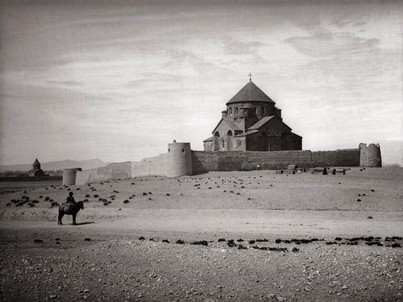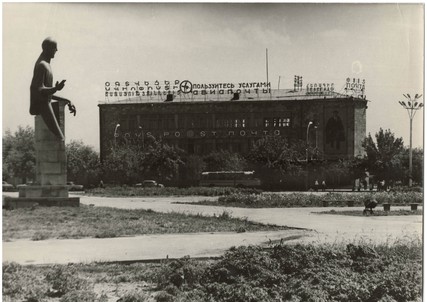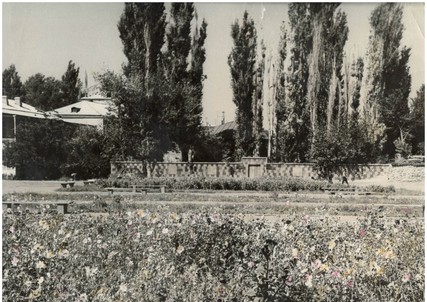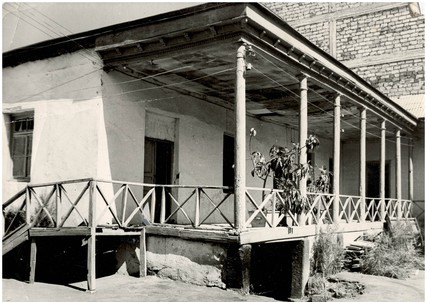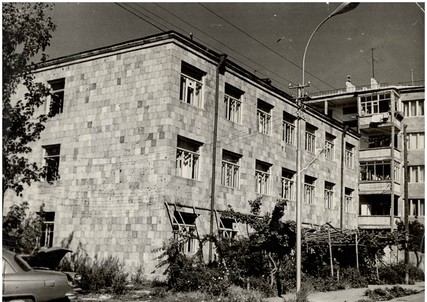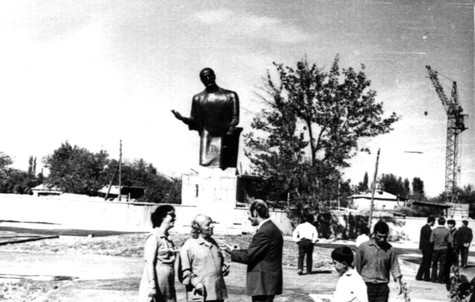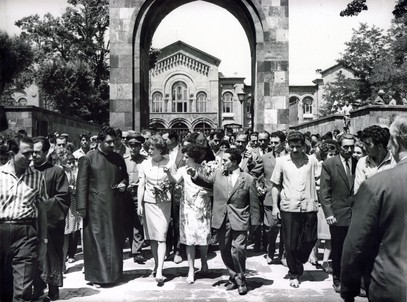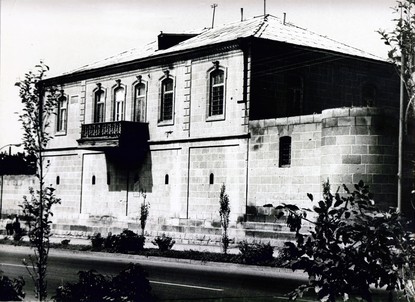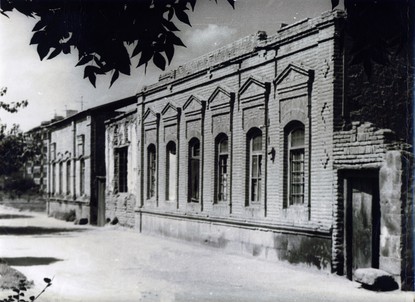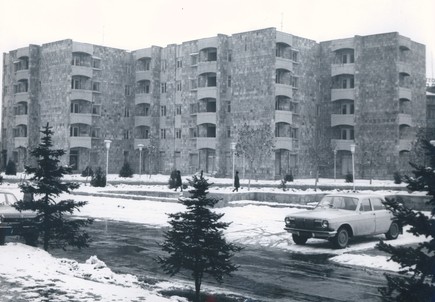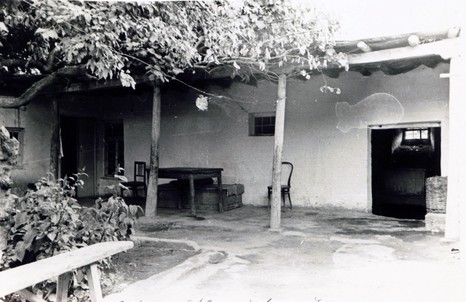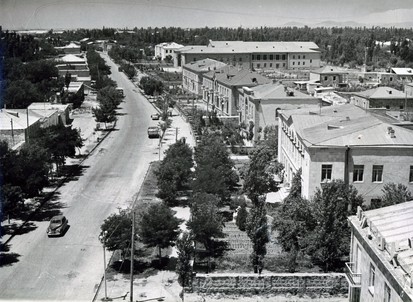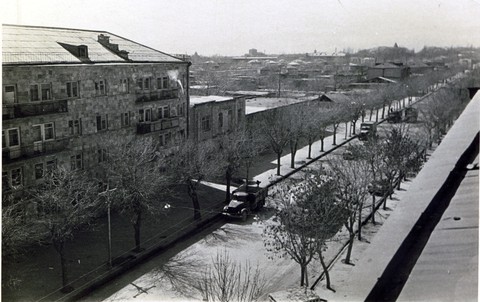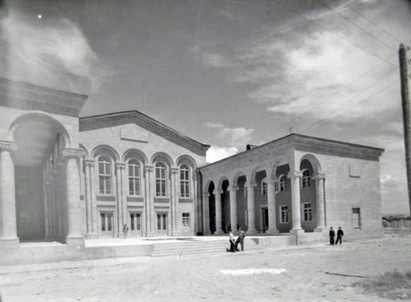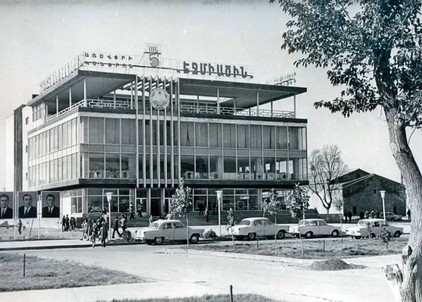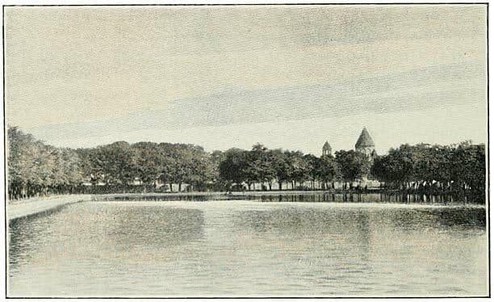Պատմություն
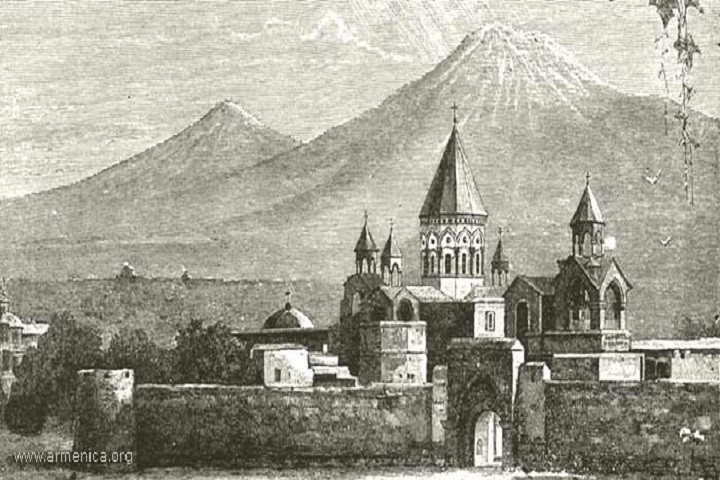
Էջմիածնի տարածքում մարդիկ բնակվել են հնագույն ժամանակներից ի վեր: Այդ են վկայում Էջմիածնի և մոտակայքի հուշարձանները (Շրեշ բլուր, Մոխրաբլուր, Ակնաշեն, Թեղուտ և այլն)` քարի, բրոնզի և երկաթի դարերի հնագիտական անընդմեջ շերտերով, որոնց պեղումների և շինարարական աշխատանքների ժամանակ հնագիտական բազմաթիվ նյութեր են հայտնաբերվել:
Էջմիածնի մասին գրավոր ամենահին տեղեկությունը պատկանում է Վանի (Արարատյան) թագավոր Ռուսա Բ-ին (մ.թ.ա. մոտ 685-645թթ.): Ըստ Զվարթնոցի սեպագիր արձանագրության` Էջմիածնի տարածքը կոչվել է Կուարլինի, որտեղ Ռուսա Բ-ն ջրանցք է անցկացրել Իլդարունի (Հրազդան) գետից:
Մեկ դար հետո հայոց Երվանդ Սակավակյաց (մ.թ.ա. 570-560թթ.) թագավորի օրոք վերջինիս փեսա Վարդգես Մանուկը այդ նույն տարածքում ` Շրեշ բլրի և Արտիմեդ քաղաքի մոտ, Քասաղ գետին ափամերձ, կառուցում է խոշոր ավան և իր անունով կոչում Վարդգեսավան:
Տիգրան Բ Մեծի (մ.թ.ա. 95-55թթ.) օրոք ավանը դառնում է վաճառաշահ քաղաքագյուղ: Վաղարշ Ա Արշակունի արքան (117-140թթ.) այն պարսպապատում ու պատվարում է և վերանվանում Վաղարշապատ` Մեծ Հայքի Այրարատ նահանգի Արագածոտն գավառում: Ապա կատարում է նաև այլ կառուցումներ և քաղաքը դարձնում երկրորդ աթոռանիստ:
163թ. հռոմեացիները Կայնեպոլիս (Նոր քաղաք) անունով այն նույնիսկ մայրաքաղաք են հռչակում `գրաված և ավերած Արտաշատի փոխարեն: Նրանք մի շարք կառուցումներ են կատարում Վաղարշապատում, հատկապես ամրացնում նրա պաշտպանական համակարգը: Այդ մասին վկայում են Էջմիածին-Զվարթնոց հատվածում հայտնաբերված լատիներեն երկու արձանագրությունները:
Հռոմեացիներին արտաքսելուց և Արտաշատը վերականգնելուց հետո պաշտոնական մայրաքաղաքը շարունակում է մնալ Արտաշատը, իսկ Վաղարշապատը մինչև հայ Արշակունյաց հարստության անկումը (428թ.), շարունակում է կատարել մայրաքաղաքին փոխարինող աթոռանիստի դեր: Այն ուներ միջնաբերդ, արքունի պալատներ, զորանոցներ, բանտ, հզոր, աշտարակավոր պարիսպներ`մի քանի դարպասներով(հատկապես նշանավոր էր արևելյան մեծ դարպասը`Արեգի դուռը): Քաղաքը հարավից պաշտպանված էր Քասաղի ջրով լցվող և Պառկեն փոս կոչվող խոր խրամով, հարավ-արևմուտքից`ընդարձակ ճահճով, որը նաև կառափնարան էր, ուր կատարվել են մահապատիժները:
Քաղաքի նշանակությունը հատկապես մեծանում է քրիստոնեությունը Հայաստանում պետական կրոն հռչակվելուց հետո(301թ.): Ագաթանգեղոսը վկայում է, որ Գրիգոր Ա Լուսավորչին տեսիլք է երևում, ըստ որի, Հիսուս Քրիստոսն իջնում է («Էջ Միածնի Որդւոյ Աստուծոյ» կամ «Էջ միածինն» (իջավ միածինը),այստեղից` Էջմիածին) Վաղարշապատ և ձեռքի ոսկե ուռով ցույց տալիս այն վայրը, որտեղ Ս. Հռիփսիմյանց կույսերի նահատակության պատվին պետք է կառուցել «տուն աղօթից»: Կատարելով «աստվածային» ցուցումը` Գրիգոր Լուսավորիչը Տրդատ Մեծի, նախարարների ու հավատացյալ ժողովրդի օգնությամբ կործանում է Սանդարամետի մեհյանը և տեղում հիմնում (301-303թթ.) Հայաստանի քրիստոնեական անդրանիկ Մայր տաճար Ս. Էջմիածինը, հայոց քահանայապետությունը և սուրբ Էջմիածնի միաբանությունը:
Այնուհետև Վաղարշապատը (հետագայում, հատկապես XIII-XV դարերից տաճարի անունով կոչվել է նաև Էջմիածին) դարձավ հայոց հոգևոր կենտրոնը, իսկ տաճարը` անկախ կաթողիկոսական աթոռանիստի տեղափոխություններից, պահպանեց մայր տաճարի առաջնային նշանակությունը:
IV դարից սկսած Էջմիածինն ունեցել է հոգևոր-մշակութային նշանակալից կյանք, շարունակ հարստացել նորանոր կառույցներով ու հիմնարկություններով: Դեռևս Գրիգոր Լուսավորչի կաթողիկոսության օրոք (302-325թթ.) կառուցվում են հայրապետանոց, միաբանների և սպասավորների կացարան (Vդարից հայտնի է Սուրենյաց անապատ անունով), հիմնադրվում Ս. Հռիփսիմյաց վկայարանները, հոգ տարվում նորահաստատ քրիստոնեության հոգևոր գործիչներ պատրաստելու և նրանց կրթության ուղղությամբ:
Այդ նպատակով բացվում են հունական ու ասորական դպրոցներ: Դպրոցներ բացվեցին նաև Ներսես Ա Մեծի օրոք (353-373թթ.):
Էջմիածինը հոգևոր-մշակութային առանձնակի վերելք է ապրում հատկապես V դարում, երբ բուռն գործունեություն են ծավալում Հայոց լուսավորիչներ Սահակ Ա Պարթևն (388-439թթ.) ու Մեսրոպ Մաշտոցը (361-440թթ.), որոնք Վռամշապուհ թագավորի սատարմամբ հիմնադրում են հայոց մեսրոպատառ առաջին դպրոցը:
Դրանից քիչ հետո Էջմիածինն իր հոգևոր գործիչներով դառնում է Վարդանանց (450-451թթ.), ապա` Վահանանց(481-484թթ.) ազատագրական պատերազմների ոգեշնչող:
Թեև 484թ. կաթողիկոսարանը տեղափոխվում է Դվին, սակայն հոգևոր-մշակութային կյանքն Էջմիածնում շարունակում է ծաղկում ապրել: 484-486թթ. Վահան Մամիկոնյանը հիմնովին նորոգում է վանքը, իսկ 486-491թթ. վանքի հոգաբարձու Ղազար Փարպեցին հիմնադրում հայոց առաջին մատենադարանը: Այնուհետև Էջմիածինը դառնում է հայ գրչության նշանավոր կենտրոն, ուր տարբեր ժամանակներում գրվում, ընդօրինակվում ու ծաղկանկարվում են զանազան բնույթի բազմաթիվ ձեռագրեր:
Հոգևոր- մշակութային և շինարարական բուռն աշխատանքներ են ծավալվում VII դարում, հատկապես Կոմիտաս Ա Աղցեցի (615-628թթ.), Եզր Ա Փառաժնակերտցի (630-641թթ.) և Ներսես Գ Տայեցի (641-661թթ.) կաթողիկոսների օրոք:
618թ. նորոգվում է Մայր Տաճարը և կառուցվում Հռիփսիմեի տաճարը, 630թ.` Գայանե եկեղեցին և քահանայական դասի կայանը, 641-661թթ.` Զվարթնոցը, նոր վեհարան, բաղնիք, ջրհոր, հնձաններ:
II դարից սկսած Էջմիածինն Արտաշատի ու Դվինի, հետագայում նաև Անիի միջոցով մասնակցում է տարանցիկ առևտրին, ուներ հոծ ու բազմալեզու բնակչություն (հայեր, պարսիկներ, հույներ, ասորիներ):
Ըստ Փավստոս Բյուզանդի՝ IV դ. վերջին քառորդում Հայաստան կատարած արշավանքների ժամանակ պարսից արքա Շապուհ II-ը Էջմիածնից գերևարում է 19 հզ. տուն մարդ: Այդ փաստը, թեև հավանական ուռճացմամբ, վկայում է, որ Էջմիածինը եղել է բազմամարդ: Էջմիածինն ունեցել է զարգացած արհեստագործություն, դարբնություն, խեցեգործություն:
Զբաղեցրել է ընդարձակ տարածություն (արևելյան Զվարթնոցից մինչև Քասաղի աջ ափը), որն արդյունք էր ոչ միայն բնակչության բազմաշատության, այլև ավատական բնատնտեսության. Հայաստանի այլ քաղաքների նման Էջմիածնի բնակիչների զգալի մասը զբաղվել է երկրագործությամբ ու գյուղատնտեսական այլ աշխատանքներով:
Չնայած այս վերելքն առժամանակ կասեցվում է VII դ. կեսից սկսված արաբական արշավանքներով ու ավերումներով, սակայն VIII դ. սկսած Էջմիածնում նորից տնտեսական աշխուժացում է սկսվում և շարունակվում Հայոց Բագրատունյաց թագավորության ամբողջ ընթացքում:
Հայոց արքա Գագիկ Բ-ի (1042-1045թթ.) այցելության միջոցին Էջմիածինը տակավին շեն էր ու բարգավաճ: Այնուհետև մնում է անհիշատակ և օտար նվաճողներից (սելջուկներ, մոնղոլներ, թաթարներ) այնքան ավերված ու ամայի, որ Ստեփանոս Օրբելյանը հատուկ "Ողբ" է գրում:
Անշուք վիճակը շարունակվում է մինչև XV դ. կեսը, երբ Հովհաննես Հերմոնացու և Թոմաս Մեծոփեցու ջանքերով 1441թ.-ին գումարված Էջմիածնի ազգային ժողովը Ամենայն Հայոց Կաթողիկոսությունը վերահաստատում է Էջմիածնում: Էջմիածինը դառնում է համայն հայության հոգևոր-կրոնական կենտրոնը և Հայոց Կաթողիկոսի աթոռանիստը, որպիսին մնում է առ այսօր:
Պատմա-քաղաքական այս խոշոր իրադարձությունը, ինչպես և երկրի վարչական կենտրոն Երևանին մոտ լինելու հանգամանքը խթան են դառնում Էջմիածնի հետագա զարգացման համար:
Հաստատվելով Էջմիածնում` Հայոց կաթողիկոսները հնարավորություն են ստանում անձամբ հետևելու քաղաքի ներքին կյանքին, միաբանության հետ զանազան միջոցառումներ ձեռնարկում տնտեսական ու մշակությաին կյանքը բարվոքելու համար:
Երբ Գրիգոր Ժ Ջալալբեկյանցը (1443-1463թթ.) գնում է Էջմիածինը և դարձնում վանքապատկան կալվածք (որպիսին մնաց մինչև 1920թ.), կաթողիկոսարանն ու միաբանությունը սկսում են խրախուսել ու հովանավորել գյուղատնտեսության զարգացումը:
Էջմիածնի բնակիչների նախկին զբաղմունքների (պտղագործություն, այգեգործություն, հացահատիկների մշակում) վրա ավելանում են նորերը` գինեգործությունը, բամբակագործությունը, գյուղատնտեսությանն օժանդակող արհեստագործությունը, ավելի ուշ` շերամապահությունը:
Տնտեսական այս աշխուժացումը որոշ ժամանակով կասեցվում է XVII դ. սկզբին պարսից Շահ Աբաս I-ի արշավանքով: Տասնյակ հազարավոր հայերի բռնագաղթից հետո՝ 1614թ. նա Էջմիածնի տաճարից տեղահան է անում և Սպահան փոխադրում 15 որմեր, աշտանակներ, Գրիգոր Լուսավորչի աջը և այլ մասունքներ՝ ցանկանալով այնտեղ մի նոր "Էջմիածին" կառուցել, որով կկարողանար նոր երկրի հետ կապել գաղթված հայերին:
Մովսես Գ Տաթևացու (1620-1655թթ.) օրոք նորոգվում են այդ ավերումները և կատարվում նոր կառուցումներ` փուռ, ամբար, սեղանատուն, տնտեսատուն, պարսպապատվում վանքը:
Լայն շինարարություն է ծավալում Փիլիպոս Ա Աղբակեցին (1632-1655թթ.): Շինարարությունը գլխավորում է Ուստա Գրիգորը, որը 1639թ. արձանագրություն է թողել Տրդատա դռան վրա: Վաղուց չէր գործում Էջմիածնի դպրոցը, միայն XVII դ. առաջին քառորդում էր փորձ արվել այն վերաբացելու, երբ "արտաքին" գիտությունների նշանավոր վարդապետ Մելիքսեդեկ Վժանցին հրավիրվել էր Էջմիածին և ուսուցանել մի քանի աշակերտ:
Այդ բացը վերացնելու համար 1635-1637թթ. Հովհանավանքի դպրատունը փոխադրվում է Էջմիածին: Առժամանակ ծաղկում է դպրոցը (1640թ. հայտնի է "Վարդապետարան" անունով), երբ այնտեղ դասավանդում են գիտնական-ուսուցչապետեր Ոսկան Երևանցին, Սիմեոն Ջուղայեցին և Ստեփանոս Լեհացին:
1645թ. Փիլիպոս Աղբակեցին ձեռնարկում է տաճարի զանգակատան շինարարությունը, որն ավարտվում է 1658թ. Հակոբ Դ. Ջուղայեցու (1655-1680թթ.) օրոք:
1694թ. իշխան Աղամալ Շոռոթեցու միջոցներով, կառուցվում է Շողակաթ եկեղեցին, իսկ Աստվածատուր Ա Համադանցու (1715-1725թթ.) օրոք Նաղաշ Հովնաթանը կատարում է Մայր տաճարի որմնանկարները:
Պատկերազարդումներն ավարտում են նրա որդիները` Հակոբ և Հարություն Հովնաթանյանները Աբրահամ Գ Կրետացու (1734-1737թթ.) օրոք: Վերջինս հմուտ դիվանագիտությամբ կարողանում է ոչ միայն Էջմիածինը զերծ պահել թուրք-պարսկական պատերազմի` Հայաստանում կատարող ավերումներից, այլև Նադիր շահի` Էջմիածին այցելության ժամանակ(1737-1751թթ.) կառուցվում են Ղազարապատի հյուրանոցը (30-ից ավելի սենյակներով), պարտեզ, ջրավազան, բաղնիք, ախոռներ, գոմեր:
Սիմեոն Ա Երևանցու (1763-1780թթ.) օրոք՝ 1768թ., հիմնովին վերակառուցվում է վանքի պարիսպը: Ուղղանկյուն պարիսպները չորս կողմերում ունեին կամարակապ չորս մեծ դռներ և ևս վեց դռներ` տարբեր կողմերում: Բուրգերը տեղադրված էին պարսիպների չորս անկյունագլուխներում և տեղ-տեղ` բոլոր կողմերում, որոնց շնորհիվ պարսպապատ վանքը ստացել էր ամրոցի նմանություն: Պարիսպների մերձակա տները քանդվում են և ավելի հեռվում կառուցվում է մի այլ եկեղեցի: Նախկին իջևանատան (քարավանսարա) շենքը կանոնավոր շուկայի է վերածվում:
1763թ. հիմնվում է երկու վարժարան (ամռան և ձմռան), որոնց ուսուցիչ-տեսուչ է նշանակվում Պետրոս Բերթումյանց (Աղամալյան) եպիսկոպոսը: Այդ վարժարանները, որոնք փաստորեն միայն բաժանմունքներ էին, այսուհետև հայտնի են "Էջմիածնի ժառանգավորաց դպրոց" անունով:
1771թ. Սիմեոն Երևանցին հիմնադրում է նաև Հայաստանում առաջին տպարանը (որտեղ 1772թ. լույս է տեսել Հայաստանում առաջին գիրքը` իր իսկ "Գիրք Աղօթից որ կոչի Զբօսարան հոգեւոր"-ը), 1776թ.` առաջին թղթի գործարանը (թղթատուն):
Էջմիածին է հրավիրվում Հովնաթան Հովնաթանյանը, որը 1769թ. սկսում է Մայր տաճարի նոր պատկերազարդումը և ավարտում Ղուկաս Կարնեցու (1780-1799թթ.) օրոք: Վերջինս ավարտում է տաճարի հիմնական վերակառուցումը: Հետագա աշխատանքները մասնակի բնույթ էին կրում և չէին աղճատում տաճարի նախնական ձևն ու տեսքը:
XVII-XVIII դդ. աշխուժանում է տնտեսական ու առևտրական կյանքը: Էջմիածնով է անցնում Թավրիզ-Երևան-Կարին քարավանային ճանապարհը: Էջմիածնեցի վաճառականները արտահանում են բամբակ, գինի և այլն:
XIX դ. սկզբին Էջմիածինը գտնվում էր ռուս-պարսկական պատերազմի (1804-1813թթ.) առաջավոր գծում: Երբ 1804թ. պարսից թագաժառանգ Աբաս-Միրզան բանակ է դնում Էջմիածնի մոտ և Երևանը պաշարած ռուսական զորքերի մեջ հիվանդություն է տարածվում, Գեներալ Ցիցիանովը թողնում է պաշարումը, մեկնում Էջմիածին և, հիվանդներին, վանքի միաբանների մի մասին ու որոշ արժեքավոր իրեր ու եկեղեցական սպասներ վերցնելով, տեղափոխվում Թիֆլիս (դրանց մի մասը վերադարձվում է պատերազմից հետո) :
1806թ. սեպտեմբերին ռուսական զորքերը կրկին գրավում են Էջմիածինը, սակայն 1813թ. Գյուլիստանի պայմանագրով ստիպված նորից զիջում պարսիկներին:
1828թ. Էջմիածինը Արևելյան Հայաստանի կազմում վերջնականապես միացվում է Ռուսաստանին: Այդ իրադարձությունը կարևոր նշանակություն է ունենում Էջմիածնի հետագա զարգացման համար:
Ազատվելով օտարերկրյա նվաճողների դարավոր բռնություններից` Էջմիածնի բնակիչները հնարավորություն են ստանում բարելավելու տնտեսական ու հոգևոր-մշակութային կյանքը:
Էջմիածնում նոր վերելք է սկսվում, որը շարունակվում է ամբողջ XIX դ.: Էջմիածինը աստիճանաբար ներգրավվում է ռուսական կառավարման ու մշակութային –տնտեսական կյանքի ոլորտում, սակայն մնում վանքապատկան և ռուսական կառավարությունը, նախկին իշխանությունների նման, նույնպես ճանաչում են միաբանության իրավունքներն Էջմիածնի վրա:
Չնայած XIX դ. կեսից Էջմիածինը դառնում է Երևանի նահանգի Էջմիածնի շրջանի կենտրոնը, այնուամենայնիվ, բուն քաղաքը կառավարում էին կաթողիկոսարանն ու միաբանությունը` սինոդի հետ մեկտեղ:
XIX դ. առաջին կեսին Էջմիածնում նշանակալից աշխատանքներ են կատարվում հատկապես Եփրեմ Ա Ձորագեղցի (1809-1830.թ), Հովհաննես Ը Կարբեցի (1831-1842թթ.) և Ներսես Ե Աշտարակեցի (1843-1857թթ.) կաթողիկոսների օրոք:
1833թ. կանգնեցվում է հուշարձան` նվիրված 1827թ. Օշականի ճակամարտում ընկած ռուս զինվորի հիշատակին, 1837թ. սկսում է գործել դեռևս 1808թ. կազմավորված սինոդը, 1847-ին սկսվում է Ներսիսյան ձկնաբույծ լճակի շինարարությունը, հոգ տարվում քաղաքը խմելու ջրով ապահովելու մասին, վերակառուցվում շուկան, Էջմիածնում և շրջակայքում տնկվում են բյուրավոր ծառեր` թթենիներ, կաղամախիներ, ուռենիներ և այլն:
1847թ. Ներսես Աշտարակեցին ընդլայնում է իր իսկ հիմնած վարժարանը: Առանձնապես հատկանշական է Գևորգ Դ. Կոստանդնոպոլսեցու (1866-1882թթ.) վարժարանը:
1868թ. մայիսին լույս է տեսնում առաջին պարբերականի «Արարատ» ամսագրի առաջին համարը: 1869թ. մայիսի 25-ին հիմնադրվում է Հայաստանում առաջին և միակ բարձրագույն հոգևոր հաստատությունը` Գևորգյան ճեմարանը: Ճեմարանին կից կառուցվում են ննջարաններ, հիվանդանոց և օժանդակ այլ շինություններ:
Նույն` 1869թ. հիմնադրվում է Էջմիածնի թանգարանը, կարգավորվում տպարանը, ընդլայնվում գրատուն-մատենադարանը, 1879թ. բացվում նրա ընթերցարանը: 1889թ. կառուցվում է տպարանի նոր շենքը, նորոգումներ ու մասնակի փոփոխություններ կատարվում վանքում ու շրջակայքում, իսկ Մկրտիչ Ա Վանեցու օրոք վանքում անցկացվում է էլեկտրական լուսավորություն:
XIX դ. վերջերից Էջմիածինը դառնում է հայ մշակույթի կարևոր կենտրոններից: Էջմիածին են հրավիրվում մշակույթի ու գիտության մի շարք գործիչներ` դասավանդելու Գևորգյան ճեմարանում կամ աշխատելու Մատենադարանում ու «Արարատ»-ի խմբագրությունում:
Էջմիածնում ապրում ու գործում էին` Կոմիտասը, Հ. Հովհաննիսյանը, Հ. Աճառյանը, Մ. Աբեղյանը, Ե. Թադևոսյանը, Գ. Տեր-Մկրտչյանը, Գ. Հովսեփյանը և ուրիշներ:
Մշակութային կյանքի վերելքին զուգընթաց աճում է բնակչությունը (1909թ. Էջմիածինն ուներ 3422բն.):
Աշխուժանում է քաղաքական կյանքը:
Սակայն Էջմիածնի զարգացումը խաթարվում է հայ-թուրքական կռիվներով: Էջմիածինը վերածվում է պատերազմի արհավիրքներից տուժած հայ գաղթականության հավաքատեղիի:
Դարեր շարունակ Էջմիածինը եղել է պետականությունից զրկված, աշխարհով մեկ սփռված հայ ժողովրդի ազգային-քաղաքական կենտրոնը: Էջմիածինը բազմիցս եղել է ազատագրական շարժման կենտրոն, իրեն է ձգտել ազատագրական շարժման բազմաթիվ գործիչներների (Էմին Հովսեփ, Մովսես Բաղրամյան, Եգոր Խուբով), իսկ 1918թ.՝ Թուրքիայի հարձակման ժամանակ, Էջմիածնի բազմաթիվ աշխարհազորայիններ, մտավորականներ ու հոգևորականներ մասնակցում էին ճակատամարտին:
Հայաստանում խորհրդային կարգեր հաստատվելուց (1920թ.) հետո Էջմիածնի զարգացումը ընթանում է ծրագրված ու կազմակերպված: Այն ընդգրկում է տնտեսության ու մշակութային բոլոր ոլորտները:
Խորհրդային իշխանության առաջին օրերից Էջմիածինը դադարում է վանքապատկան լինելուց և դառնում Վաղարշապատի գավառի կենտրոնը: Էջմիածինը սկսում է ապրել նոր կյանքով:Միջոցներ են ձեռնարկվում բարելավելու Էջմիածնում հավաքված բազմահազար գաղթականների վիճակը: Նրանց մի մասը մշտապես հաստատվում է Էջմիածնում:
Շինարարական-տնտեսական և կրթական-մշակութային աշխույժ եռուզեռ է սկսվում: Կառուցվում են տներ, արհեստանոցներ, բացվում դպրոցներ, ակումբներ, Մատենադարանը վերածվում է Նյութական մշակույթի ինստիտուտի (1921թ.) և դրվում գիտական հասարակայնության տրամադրության տակ:
1944թ. հրատարակվում է Հայրապետական Աթոռի «Էջմիածին» ամսագիրը, 1945թ. բացվում է Էջմիածնի հոգևոր ճեմարանը: 1950-1960թթ. ճարտարապետական նոր կառույցներին զուգընթաց ուշադրություն է դարձվում նաև հների բարեկարգմանը. նորոգվում են Հռիփսիմեի տաճարը, Գայանե եկեղեցին, բարեկարգվում Զվարթնոցի շրջակայքը: Կաթողիկոս Վազգեն Ա Պալճյանի նախաձեռնությամբ մեծ շինարարարություն է ծավալվում Էջմիածնի վանքում: Կառուցվում է նոր վեհարան, կանգնեցվում Մեծ Եղեռնի զոհերի հուշարձան, վերականգնվում Մայր տաճարի որմնանկարները:
Դարավոր կառուցումներից ու վերակառուցումներից հետո 1960-ական թթ. վերջին վերջնականապես ամբողջականացավ Էջմիածնի վանքի համալիրը, որն այժմ ոչ միայն Էջմիածնի տաճարի գլխավոր անսամբլներից է, այլև հայ ճարտարապետության գոհարներից:
Հայաստանում քրիստոնեության գլխավոր կենտրոնը լինելու շնորհիվ՝ Էջմիածինը դարեր շարունակ երկրի համար ունեցել է հոգևոր-մշակութային մեծ նշանակություն: Այստեղ են հիմնվում առաջին դպրոցը, մատենադարանը և ճեմարանը: Հենց այստեղ են Մեսրոպ Մաշտոցը և Սահակ Պարթևը հիմնում հայալեզու առաջին դպրոցը: Էջմիածնում է հիմնադրվում Հայաստանում առաջին տպարանը (1771թ.), թղթի գործարանը (1776թ.), պարբերականը (1868թ.), թանգարանը (1869թ.): Էջմիածնում են գտնվում հայ ճարտարապետության գլուխգործոցներ Սուրբ Հռիփսիմե վանքը (618թ.), Սուրբ Գայանե վանքը (630թ.), Սուրբ Շողակաթ եկեղեցին (1694թ.), Սուրբ Մարիամ Աստվածածին եկեղեցին (1767թ.), Զվարթնոց տաճարը (641-661թթ.):
Այսօրվա Էջմիածնի հատակագծման աշխատանքները սկսվել են Ալեքսանդր Թամանյանի գլխավորությամբ, 1925թ.-ին:
1939-1943թթ. կազմվել է քաղաքի գլխավոր հատակագիծը, ուր հաշվի են առնվել դարերով կազմավորված տեղանքի առանձնահատկությունները, պատմաճարտարապետական հուշարձանների առկայությունը և բնական պայմանները: Ճարտարապետական հիմնական անսամբլները կողմնորոշվել են դեպի Արարատ, մասամբ դեպի Արագած լեռը, հաշվի են առնվել նաև քաղաքի հետագա զարգացման և տուրիզմի հարաճուն ծավալման պահանջները:
Քաղաքի կենտրոնի կառուցապատումը ձևավորվել է Կոմիտասի անվան հրապարակով` քաղաքապետարանի վարչական շենքի և վանքի համալիրի անսամբլային մասնակցությամբ:
Ներկայիս Էջմիածինը հանրապետության գեղեցիկ և ինքնատիպ ճարտարապետական կերպար ունեցող քաղաքներից մեկն է: Այն` շնորհիվ Մայր Աթոռ Սուրբ Էջմիածնի, դարձել է հանրապետության այցելուների և տուրիզմի ամենահետաքրքիր վայրերից մեկը: Քաղաքն այժմ զբաղեցնում է 4424 հա հողատարածք և ունի գրեթե 60 հազար բնակչություն:
Քաղաքի առողջապահական համակարգում ընդգրկված են հիվանդանոցներ, պոլիկլինիկաներ, ատամնաբուժարաններ, ծննդատուն, շտապօգնության և հիգիենիկ հակահամաճարակային պետական ձեռնարկություններ:
Քաղաքը նախկինում համարվել է խոշոր արդյունաբերական կենտրոն`իր տարածքում ունենալով ժամանակակից տեխնիկայով ու սարքավորումներով հագեցված այնպիսի հզոր գործարաններ, ինչպիսիք են «Ռաստր», «Ռեզիստր», «Էլեկտրոն» և «Սարքաշինական» գործարանները, որոնք գործել են միութենական ռազմաարդյունաբերության համալիրի կազմում և թողարկել գերճշգրիտ սարքեր:
Ներկայում այդ գործարաններն աշխատում են ոչ լրիվ հզորությամբ, սակայն պահպանել են իրենց ներուժը և ունեն վերագործարկման լուրջ հեռանկարներ: «Պլասմասա», «Գրանիտ», «Հայքար», «Շինարարական նյութերի և իրերի կոմբինատ» և «Կարին» գործարաններն իրականացնում են լայն սպառման ապրանքների և կենցաղային իրերի արտադրություն:
Քաղաքն ունի գյուղմթերքների արտադրության զարգացման մեծ հնարավորություն: Շուրջ 2000 հա հողատարածք օգտագործվում է այդ նպատակով: Զարգացած է խաղողագործությունը, պտուղ-բանջարաբոստանային և հացահատիկային կուլտուրաների մշակությունը:
Քաղաքում գործում են գինու և կոնյակի գործարաններ:
Հզոր հնարավորություններ ունեն նաև պահածոների երկու խոշոր գործարանները, որոնք իրականացնում են գյուղմթերքների վերամշակում: Քաղաքի շրջակայքում արհեստական բազմաթիվ լճերի առկայությունը, բնակլիմայական նպաստավոր պայմանները զարգացման հնարավորություններ են ստեղծում ձկնաբուծական` հատկապես իշխան տեսակի ձկան աճեցման համար, որը մեծ պահանջարկ ունի ԱՊՀ և եվրոպայական շուկայում: Կան նաև հացաբուլկեղենի արտադրության ձեռնարկություններ: Քաղաքում գործում է տրանսպորտային խոշոր ձեռնարկություն:
Գործում են 13 դպրոց, 8 մանկապարտեզներ, 2 մարզադպրոց, որտեղ գործում են ֆուտբոլի, ծանրամարտի, ըմբշամարտի, շախմատի, գիմնաստիկայի, բասկետբոլի և վոլեյբոլի խմբեր, որոնք ՀՀ տարբեր առաջնություններին մասնակցում են իրենց հավաքական կազմերով:
Քաղաքն ունի 2 երաժշտական դպրոց, գեղարվեստի դպրոց, 5 թանգարան, 1 մշակույթի տուն, 7 գրադարան, պետական քոլեջ և «Գրիգոր Լուսավորիչ» համալսարան: Էջմիածնի Մայր աթոռին կից գործում է Գևորգյան ճեմարանը:
Հանրապետությունում առաջին գիտահետազոտական հիմնարկներից մեկը` Հայաստանի կուլտուր-պատմական ինստիտուտը բացվել է Էջմիածնում, որը հետագայում վերակազմվեց և տեղափոխվեց Երևան:
Էջմիածինն իր երկար ու ձիգ պատմության ընթացքում տվել է հայ մշակույթի շատ երախտավորներ, քաղաքական – հասարակական ականավոր գործիչներ` Կոմիտաս, Հովհ. Հովհաննիսյան, Հր. Աճառյան, Մ.Աբեղյան, Ե. Թադևոսյան, Մ. Եկմալյան, Ս. Մելիքյան, Ռ. Մելիքյան, Վ. Կոստանյան և ուրիշներ:
Քաղաքի առօրյան լի է բազմաթիվ մշակութային միջոցառումներով:
Քաղաքում գործում են հասարակական տարբեր կազմակերպություններ` «Երկրապահ կամավորականների միություն», «Մեր տուն» ՀԿ, «Ռոսիա» ՀԿ, «Հայ միասնության խաչ» բարեգործական-հասարակական կազմակերպությունը:
Էջմիածին քաղաքի իշխանությունն անում է հնարավորը հայ և օտարազգի զբոսաշրջիկներին ու հյուրերին հինավուրց քաղաքը բարետես ներկայացնելու համար: Վերանորոգվում ու լուսավորվում են փողոցները, ավելացվում են կանաչ տարածքները, բարեկարգվում են բակերն ու զբոսայգիները, քաղաքի հին ճարատարապետական կողթողների կողքին ավելանում են նորերը` Մակար Եկմալյանի կիսանդրին և Արցախյան ազատամարտին նվիրված հուշակոթողը քաղաքապետարանի հարակից այգում, Չարենցի արձանը մեծ բանաստեղծի անունը կրող թաղամասում և այլն:
Էջմիածինն ակտիվ համագործակցում է տարբեր միջազգային կազմակերպությունների և քաղաքների հետ: Քաղաքը բարեկամական կապեր ունի Իսի Լե Մուլինո, Շաղվիո Շավանիո (Ֆրանսիա), Ֆրեզնո (ԱՄՆ), Պետրոզավոդսկ, Սերգիև-Պոսադ(ՌԴ), Վելիկո-Տրնովո (Բուլղարիա), Բելգորոդ-Դնեստրովսի (Ուկրաինա), Մցխեթա (Վրաստան), Դաուգավպիլս (Լատվիա), Մարտակերտ և Հադրութ (ԱՀ) քաղաքների հետ:
Էջմիածինը նաև ՅՈՒՆԵՍԿՕ-ի «Համաշխարհային ժառանգության քաղաքներ» կազմակերպության անդամ է:
Այսպիսով՝ V դարից ի վեր Էջմիածինը եղել է ոչ միայն հայ ժողովրդի նշանավոր ուխտատեղի, այլև մշակույթի հին ու նոր կոթողներով գրավել այլազգի գիտնականների, գրողների, բանաստեղծների, պետական ու քաղաքական գործիչների և ճարտարապետների ուշադրությունը:
Էջմիածնեցին անկեղծորեն սիրում է իր քաղաքը և, իրավմամբ, հպարտանում նրա ավելի քան 2700-ամյա փառավոր պատմությամբ: Բայց նաև, միաժամանակ, խորապես համոզված է, որ ինքն անբաժան է այդ պատմությունից, ավելին՝ այն կերտողներից մեկն է, ուստի պարտավոր է անել իրենից կախված հնարավորը, որ համայն հայության հոգևոր կենտրոն, ալեհեր ու հավերժ երիտասարդ իր սիրելի քաղաքի ապագան լինի առավել գեղեցիկ ու լուսավոր:
Լուսանկարներ
